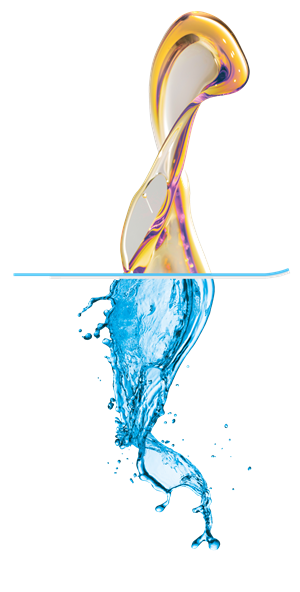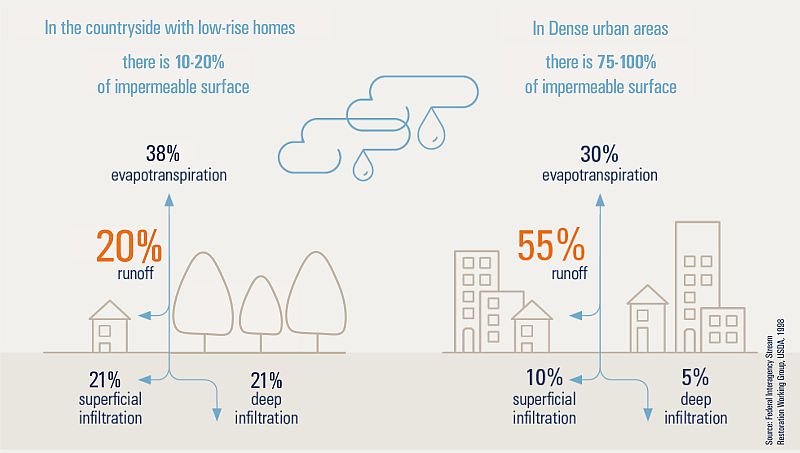Did you know?
Large amounts of hydrocarbons are released on road surfaces every day. Around 1 to 5 litres of hydrocarbons are released each day on every kilometer of heavily trafficked roads.
The rate is about 0.2 ml/m²/week on car parks.
For example, oil leaks reach up to about 200 litres of oil /year on a 20,000 m² car park with 400 car slots.
A large proportion of these hydrocarbons may infiltrate.
While around 30% of these hydrocarbons degrade in the open air, 70% may be carried off by runoff, infiltrating the soil and polluting the subsurface and aquifers.

ONE LITRE OF OIL CAN CONTAMINATE:
- 1,000,000 litres of natural water
- 1 m3 of soil
ONE LITRE OF OIL CAN COVER:
- 1,000,000 m² of water surface (100 hectares)
LARGE RUNOFF VOLUMES
The higher occurrence of heavy rains on larger impervious
areas produces big volumes of runoff water which increases
the risk of urban floods.
A rare, fragile and essential natural resource
Only 0.8% of the total existing water on earth can be used for human needs.
A few figures…
Increasing population and urban areas.
- World's population increased by nearly 25% in 30 years, among which 72% live in urban areas
- Dense urban areas comprise more than 70% impervious artificial surfaces on average.
- Impervious surfaces in Europe have increased by 38% in the last 25 years.

Climate change
Climate change has led to greater occurrences of extreme meteorological events. Heavy rains are becoming even more intense, impermeable surfaces are producing substantial volumes of runoff water, and the risk of flooding has increased.
Urbanisation produces significant volumes of runoff water...
- The largest proportions of impermeable surfaces are the urban and peri-urban areas:
75% to 100% of impermeable surfaces in cities
- Impermeable surfaces produce 4 to 20 times more runoff water that a pervious area:
55% of rainwater runoff in cities compared to 20% in rural areas
…and runoff water is polluted:
- Roads, car parks and railways are polluted by oil and grease leaks
- The average hydrocarbon deposits on a main road pavement is about 1 to 5 l/km/day
Human activities and hydrocarbon pollution
The conjunction of an extensive use of the water resource and the resulting pollution shall be managed in a way that no environmental degradation occurs, but at least the water quality is preserved and even restored.
Today, very expensive depolluting technologies are currently required to keep the quality of the natural fresh water high enough for drinking.
Rainwater can infiltrate locally through permeable surfaces: green roofs, green spaces, and permeable roads.
These roads can be made of porous mineral or concrete pavement, gravel, or grassy soil enclosed in honeycomb-type mats.
Depending on the permeability of the existing soil, permeable roads can directly infiltrate water into the subsoil or be combined with underground retention systems such as ultra-lightweight structures with crates.
A large proportion of these hydrocarbons may infiltrate the soil.
While around 30% of these hydrocarbons degrades in the open air, 70% may be carried off by runoff, infiltrating the soil and polluting the subsurface and aquifers.
To protect aquifers, it is essential to design infrastructure that promotes local infiltration of rainfall and cleans polluted runoff water prior to infiltration.

